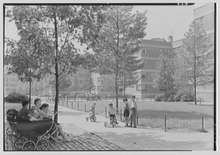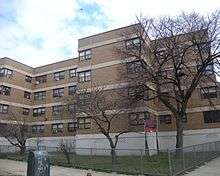Williamsburg Houses
The Williamsburg Houses, originally called the Ten Eyck Houses, (pronounced TEN-IKE) is a public housing complex built and operated by the New York City Housing Authority (NYCHA) and located in Williamsbug, Brooklyn and is bordered by Scholes Street to Maujer Street and Leonard Street to Bushwick Avenue.[2]
| Williamsburg Houses | |
|---|---|
Humboldt and Scholes Streets | |

| |
| Former names | Ten Eyck Houses |
| General information | |
| Location | Brooklyn, New York City |
| Country | United States |
| Coordinates | 40°42′36″N 73°56′36″W |
| Construction started | 1936 |
| Opened | April 10, 1938 |
| Cost | $12.5 million |
| Owner | New York City Housing Authority |
New York City Landmark | |
| Designated | June 24, 2003[1] |
| Reference no. | 2135A |
New York City Council politician Rosie Méndez grew up in the development.[3] The Williamsburg Houses were designated a New York City Landmark in 2003.
History

The Williamsburg Houses were built in 1936–1938 under the auspices of the Housing Division of the Public Works Administration (PWA).[4] The project was originally segregated, only allowing white residents.[5] It was one of the first and most costly (in 1937 dollars) of New York City housing projects. New York City Mayor Fiorello La Guardia poured the first shovel of concrete for the project and was a strong supporter of the project despite its cost ($12.5 million in 1936).[6] The site is the former home of Williamsburg Continuation School and the Finco Dye and Print Works Inc.

The chief architect of the project was Richmond Shreve, and the design team of nine other architects was led by the Swiss-American modernist William Lescaze, whose Philadelphia Saving Fund Society building of 1928-32 was one of the first major International Style buildings in the United States. The construction contract was awarded to Starrett Brothers & Eken, which had worked closely with Shreve on the Empire State Building and later built the housing developments Parkchester, Stuyvesant Town, and Peter Cooper Village.
The initial tenancy rents were set by WPA Secretary Ickes in August 1937, four months before the first tenants moved in. The building's commercial rents were also set, though within six months were decreased by 50%, a result of cheaper rents available in the nearby tenements.
The housing developments were conveyed by the federal government to the NYCHA in 1957. A $70-million-dollar renovation[7] was done in 1999 by the NYCHA's architect David J. Burney.
The housing developments are a mix of Hispanic, African-American families, with gentrification as an ongoing process that is transforming the landscape.
Design
Standing between Maujer and Scholes Streets, and Leonard Street and Bushwick Avenue, its 20 four-story residential buildings occupy twelve city blocks. The buildings of the Williamsburg Houses are positioned to allow a sequence of courtyards, playgrounds, and ball courts between them; a school and community building are part of the site plan, and two curving pedestrian pathways cut through the grounds. all in three shapes; a capital “H”, lowercase “h,” and a “T” shape. The “T” shaped buildings are in the middle of the complex with both “H” shaped buildings surrounding them. The houses are oriented towards the sun at a 15-degree angle.[8]
Art

Because of its innovative International Style design, the housing project designs called for the inclusion of modern art. Working with Lescaze, the NYC Federal Arts Project mural division, headed by abstract artist Burgoyne Diller, handled the commissions. Five abstract murals by Ilya Bolotowsky, Balcomb Greene, Paul Kelpe, and Albert Swinden were installed in basement meeting rooms in the late 1930s. Three of them long-covered over with paint, these murals were rediscovered in the late 1980s. After careful removal and restoration, the Williamsburg murals were installed at the Brooklyn Museum in 1990, where they remain on long-term loan from the NYCHA.[9]
Other artists received commissions for the project but their murals were ultimately not used. Stuart Davis painted a large semi-abstract mural entitled Swing Landscape for the project, but the work was instead sold by the Federal Art Gallery in New York, eventually landing up at the Indiana University Art Museum.[10] Francis Criss completed a 1938 oil-on-canvas mural called Sixth Avenue El, a realist abstraction of a Sixth Avenue El platform. The subject was timely, given that the elevated line was closed in late 1938 and razed in 1939. However, Criss's mural was never installed, instead being located at the Whitney Museum of American Art. According to Time magazine, it was rejected because the color scheme did not match the prescribed colors for the project.[11]
Other artists engaged for the mural commissions were Jan Matulka, Byron Browne, George McNeil, Willem de Kooning, Harry Bowden, and Eugene Morley. Abstract sculptures, including work by Martin Craig and Jose de Rivera, were also part of the initial plans.[12][13] The status of the uncompleted murals and sculptures has not been fully established.
Notable people
- Rosie Mendez, New York City Council politician
References
- Landmarks Preservation Commission. "Williamsburg Houses" (PDF). NYC.gov. Retrieved August 17, 2020.
- "3 Jan 1936, Page 1 - The Brooklyn Daily Eagle at Newspapers.com". Newspapers.com. Retrieved October 21, 2019.
- admin (February 19, 2016). "5 NY politicians who grew up in public housing". CSNY. Retrieved October 21, 2019.
- "14 Oct 1936, Page 3 - The Brooklyn Daily Eagle at Newspapers.com". Newspapers.com. Retrieved October 21, 2019.
- Rothstein, Richard (May 2, 2017). The Color of Law: A Forgotten History of How Our Government Segregated America. Liveright. p. 23. ISBN 9780616963708.
- "La Guardia hails housing advance", The New York Times. April 15, 1936. Page 3.
- Landmarks Preservation Commission Designation Report, LP-2135, June 24, 2003, p. 9.
- Spellen, Suzanne (November 13, 2012). "Walkabout: The Williamsburg Houses, Part 2". Brownstoner.com. Brownstoner. Retrieved August 17, 2020.
- William H. Honan, "Long-Lost Brooklyn Housing Murals are Being Restored", New York Times, July 20, 1988
- Indiana University Art Museum website
- "Art: Architectural Painting", Time, June 6, 1938.
- Marlene Park and Gerald Markowitz, New Deal for Art: The Government Projects of the 1930s with Examples from New York City and State, Gallery Association of New York State, 1977, p. 53.
- Eleanor Carr, "New York Sculpture during the Federal Project," Art Journal 31 (Summer 1972): 402.